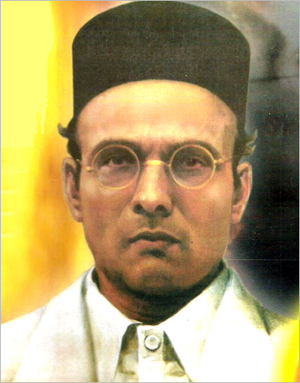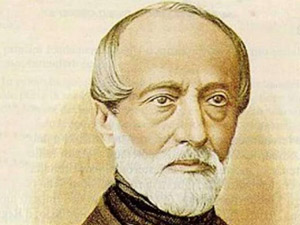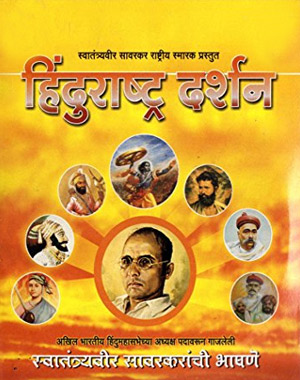 Vinayak Damodar Savarkar is known to people as one of the fervent freedom fighters of India. But he was not just a freedom fighter. He was a bold warrior, good orator, prolific writer, a poet, a historian, a philosopher, a social worker, a cautious leader, a bard and staunch supporter of Freedom and much ore. The following article is a glimpse of what we mean by his multifaceted personality. His biography is like a thrilling novel. It inspires readers with patriotism.
Vinayak Damodar Savarkar is known to people as one of the fervent freedom fighters of India. But he was not just a freedom fighter. He was a bold warrior, good orator, prolific writer, a poet, a historian, a philosopher, a social worker, a cautious leader, a bard and staunch supporter of Freedom and much ore. The following article is a glimpse of what we mean by his multifaceted personality. His biography is like a thrilling novel. It inspires readers with patriotism.
He hailed from Maharashtra,. Born in Bhagur, Dist. Nashik on 28th May 1883, he spent his youth in fighting against British Raj. As an extremely brilliant, outspoken and confident school boy, he was famous amongst his teachers and friends. In 1898 when Chaphekar brothers were hanged for assassinating the British Officer – Mr. Rand, Savarkar was just 15 years old. But Chaphekar’s martyrdom impressed him and he decided the freedom of the country as his foremost aim.
 After matriculation in 1901, he took admission in Fergusson College of Poona. He was however more interested in India’s freedom from British rule. The young college students in Poona were charged by the speeches by the patriots and political leaders like Bal Gangadhar Tilak, Bhopatkar etc. The news papers in Poona were also actively participating in creating anti-British atmosphere in the society and appealing society’s feelings of Nationalism. Savarkar was the uncrowned leader of the youth in this movement. In 1905 he burnt the imported clothes as a token of India’s protest to imported clothes. In May 1904, he established an International Revolution Institute named “Abhinav Bharat”. His instigating patriotic speeches and activities irritated the British Government. As a result his B.A. degree was withdrawn by the Government. In June 1906 he left for London to become Barrister. However, once in London, he united and inflamed the Indian students in England against British. He believed in use of arms against the foreign rulers and created a network of Indians in England, equipped with weapons. Although he passed Barrister Examination in England, because of his anti-government activities, he was denied the Degree.
After matriculation in 1901, he took admission in Fergusson College of Poona. He was however more interested in India’s freedom from British rule. The young college students in Poona were charged by the speeches by the patriots and political leaders like Bal Gangadhar Tilak, Bhopatkar etc. The news papers in Poona were also actively participating in creating anti-British atmosphere in the society and appealing society’s feelings of Nationalism. Savarkar was the uncrowned leader of the youth in this movement. In 1905 he burnt the imported clothes as a token of India’s protest to imported clothes. In May 1904, he established an International Revolution Institute named “Abhinav Bharat”. His instigating patriotic speeches and activities irritated the British Government. As a result his B.A. degree was withdrawn by the Government. In June 1906 he left for London to become Barrister. However, once in London, he united and inflamed the Indian students in England against British. He believed in use of arms against the foreign rulers and created a network of Indians in England, equipped with weapons. Although he passed Barrister Examination in England, because of his anti-government activities, he was denied the Degree.
He was the prime inspiration for the Indian students to rise against British rule. The British Government Officers were waiting for some opportunity to arrest him. He was arrested in London on 13 March 1910 on some fabricated offenses. The case against him was to be heard by the court in India. So he was to be sent to India. During his travel in a ship, as the ship neared Marseilles in France, he jumped through a porthole and swam to the port. This was on 8 July 1910. As per the plan, his colleagues were to reach there beforehand. However, they reached late and he was caught by French Police. The French Government denied him asylum.
 After the case was decided in India, he was sentenced to 50 years rigorous life imprisonment in Andaman on 24 December 1910. Since 4 July 1911, he was in Andaman Jail in solitude. On 2nd May 921 he was brought to India from Andaman. Since 1921 to 1922, he was in Alipur (Bengal) and Ratnagiri (Maharashtra) Jails. On 6th January 1924, he was released from the jail on two conditions viz. a) He will not actively participate in politics and b) he will stay in Ratnagiri District. He was in house arrest at Ratnagiri.
After the case was decided in India, he was sentenced to 50 years rigorous life imprisonment in Andaman on 24 December 1910. Since 4 July 1911, he was in Andaman Jail in solitude. On 2nd May 921 he was brought to India from Andaman. Since 1921 to 1922, he was in Alipur (Bengal) and Ratnagiri (Maharashtra) Jails. On 6th January 1924, he was released from the jail on two conditions viz. a) He will not actively participate in politics and b) he will stay in Ratnagiri District. He was in house arrest at Ratnagiri.
Thereafter he spent his life in different fields of social work. He breathed his last at the age of 83, on Saturday, February 26, 1966. “Prayopveshana”, meaning fast till death, was what he observed and refused any intake of food. His death was like a true warrior. Death did not grab him, he approached death with erect head.
Right from his childhood he used to like reading. Invariably found in Library, he used to read the news papers like Kesari, Kal, Dnyanprakash etc. He read “Short History of the World” in childhood. He studied History of India from Vedic time. History was his favorite subject. He had good command over Sanskrit and thoroughly read Sanskrit as well as English literature. Amongst other books, he was impressed by the biographies of Mazini, Garibaldi, Napoleon etc. He read Bible, and Holy Koran, philosophers like Spencer, Mill, Darwin, Huxlay, Emerson etc. He also studied Economics, Geology etc. He could by heart half of Ravindranath Tagore’s literature. He had also carefully studied Lenin and Trotsky.
He is proved to be pioneer in many fields such as –
He was against the influence of Urdu, English or any other languages on Marathi – his mother tongue Hence he professed for use of pure Marathi Language. To replace many conversant words adopted from languages like Urdu, Persian or English, he coined many words and brought them in use. Since Marathi originates from Sanskrit, which is a proliferate language, why should invasion of words from other languages be tolerated, he used to emphasis. The following Marathi words, which we use in day to day language are brought in by Savarkar – Prashala (High school), Aacharya (Principal), Dhani (Malak – Owner), Dinank (Tarikh – date), Upasthita (hajar – present), Nabhowani (radio), Mahapour (mayor), Vishwasta (Trustee) etc.
 Realizing the importance and influence of print media, he made appropriate changes in the Devnagari script, so as to ease printing. “Savarkar script” reduced print type faces from 200 to 80. He was the President of Hindu Mahasabha and toiled for building Hindu Nationalism. He campaigned for incorporation of Hindus in Indian Military from 30% to 65% during British Raj.pparently this was misunderstood as helping British for fighting the Second World War. However military training was very essential for the revolution, which could be used against British Rule on opportune time. That was the purpose of this campaign. This was appreciated by Netaji Subhash Chandra Bose saying that this movement facilitated supply of trained soldiers to his “Swatantra Sena”.
Realizing the importance and influence of print media, he made appropriate changes in the Devnagari script, so as to ease printing. “Savarkar script” reduced print type faces from 200 to 80. He was the President of Hindu Mahasabha and toiled for building Hindu Nationalism. He campaigned for incorporation of Hindus in Indian Military from 30% to 65% during British Raj.pparently this was misunderstood as helping British for fighting the Second World War. However military training was very essential for the revolution, which could be used against British Rule on opportune time. That was the purpose of this campaign. This was appreciated by Netaji Subhash Chandra Bose saying that this movement facilitated supply of trained soldiers to his “Swatantra Sena”.
At his instance, Madam Cama represented India in the International Socialists Conference with India’s flag. The participants in the conference not only saluted Indian Flag, but also agreed that they should support the freedom movement in India. After India’s independence, while deciding the flag of the country, Savarkar’s suggestion to adopt Dharmachakra on the Sarnath Pillar (Ashok Stambh) was accepted and implemented.
 Savarkar was a prolific writer and poet. His literature from the age of 11 till 70 can be divided in five parts. The first part consists of poems and ballads, mainly related to freedom movement. The second part consists of his writings while being in England. Amongst them “Giuseppe Mazzini”- a biography of the famous Italian freedom fighter – is world famous. Another one is “Sattavanche watryantsamar” – “The freedom fight of 1857”, which is a deep study of the 1857 “Mutiny” (as called by British) in India. He also wrote “Shikhancha Itihas” (History of Shikhs). He used to write in the Indian news papers called “Kal” and “Vihari” on various politics related topics.
Savarkar was a prolific writer and poet. His literature from the age of 11 till 70 can be divided in five parts. The first part consists of poems and ballads, mainly related to freedom movement. The second part consists of his writings while being in England. Amongst them “Giuseppe Mazzini”- a biography of the famous Italian freedom fighter – is world famous. Another one is “Sattavanche watryantsamar” – “The freedom fight of 1857”, which is a deep study of the 1857 “Mutiny” (as called by British) in India. He also wrote “Shikhancha Itihas” (History of Shikhs). He used to write in the Indian news papers called “Kal” and “Vihari” on various politics related topics.
The third part is during his imprisonment in Andaman. While enduring the rigorous imprisonment, he did not get even pen and paper to write. In such adverse conditions he wrote “Kamala” – an epic on the prison walls with the help of shart thorns.
 The fourth part is after he was shifted to Ratnagiri under house arrest. The immortal book “Mazi Janmathep” (My life imprisonment) was written during this period. It describes the dreadful life in prison. This part also includes his “Vidnyannishtha Nibandh” (scientific essays), three dramas named “Ushshap”, “Sanyasta Khadga” and “Uttarkriya” regarding imancipation of untouchables, conversion of religion and the adverse effects of extremity of “Ahinsa” on the nation, “Kale Pani” (Black water) – a novel based on his experiences in Andaman Jail and “Mala kay tyache” (What do I care?), on the background of the mutiny of Mopla- Muslims in Malbar. He wrote two books in English named “Hindutwa” and “Hindupadapadshahi” on the history of Marathas.
The fourth part is after he was shifted to Ratnagiri under house arrest. The immortal book “Mazi Janmathep” (My life imprisonment) was written during this period. It describes the dreadful life in prison. This part also includes his “Vidnyannishtha Nibandh” (scientific essays), three dramas named “Ushshap”, “Sanyasta Khadga” and “Uttarkriya” regarding imancipation of untouchables, conversion of religion and the adverse effects of extremity of “Ahinsa” on the nation, “Kale Pani” (Black water) – a novel based on his experiences in Andaman Jail and “Mala kay tyache” (What do I care?), on the background of the mutiny of Mopla- Muslims in Malbar. He wrote two books in English named “Hindutwa” and “Hindupadapadshahi” on the history of Marathas.
After he was released from house arrest he became the President of Hindu Mahasabha. His presidential addresses have been compiled in “Hindu Rashtra Darshan” which throws light on his political thinking.  In the fifth and the last part, after he retired from day to day political work, he wrote Hindurashtrachya itihasateel saha soneri pane” (Six golden pages in the History of Hindu Nation) about the critical study of History of Hindus. So far the impression was that Hindus have always been losing the battle, which is not true. He has quoted the heroism of Hindus, which gives Hindus stimulus and pride of their glorious legacy. His contribution of Marathi literature is invaluable. Therefore he was selected as the President of Maharashtra Sahitya Sammelan in 1938.
In the fifth and the last part, after he retired from day to day political work, he wrote Hindurashtrachya itihasateel saha soneri pane” (Six golden pages in the History of Hindu Nation) about the critical study of History of Hindus. So far the impression was that Hindus have always been losing the battle, which is not true. He has quoted the heroism of Hindus, which gives Hindus stimulus and pride of their glorious legacy. His contribution of Marathi literature is invaluable. Therefore he was selected as the President of Maharashtra Sahitya Sammelan in 1938.
Nagpur University and Poona University conferred on him the Honorary D.Lit. degree on 14th August 1943 and on 8th October 1959 respectively. After India’s independence, he had to face the judicial inquiry for assassination of Gandhiji, since Nathuram Godse, Gandhiji’s assassinator was the disciple of Savarkar. No charges were proved against him.
His two very famous poems are Sagara Pran Talamalala and Jayostute. He was a living “Sthitapradnya” as described in “Bhagwat Geeta” and used to live as per the philosophy of “Bhagwat Geeta”. His house in Bhagur, 9 kilometers away from Nashik, is being preserved as National Monument by the Government of India.